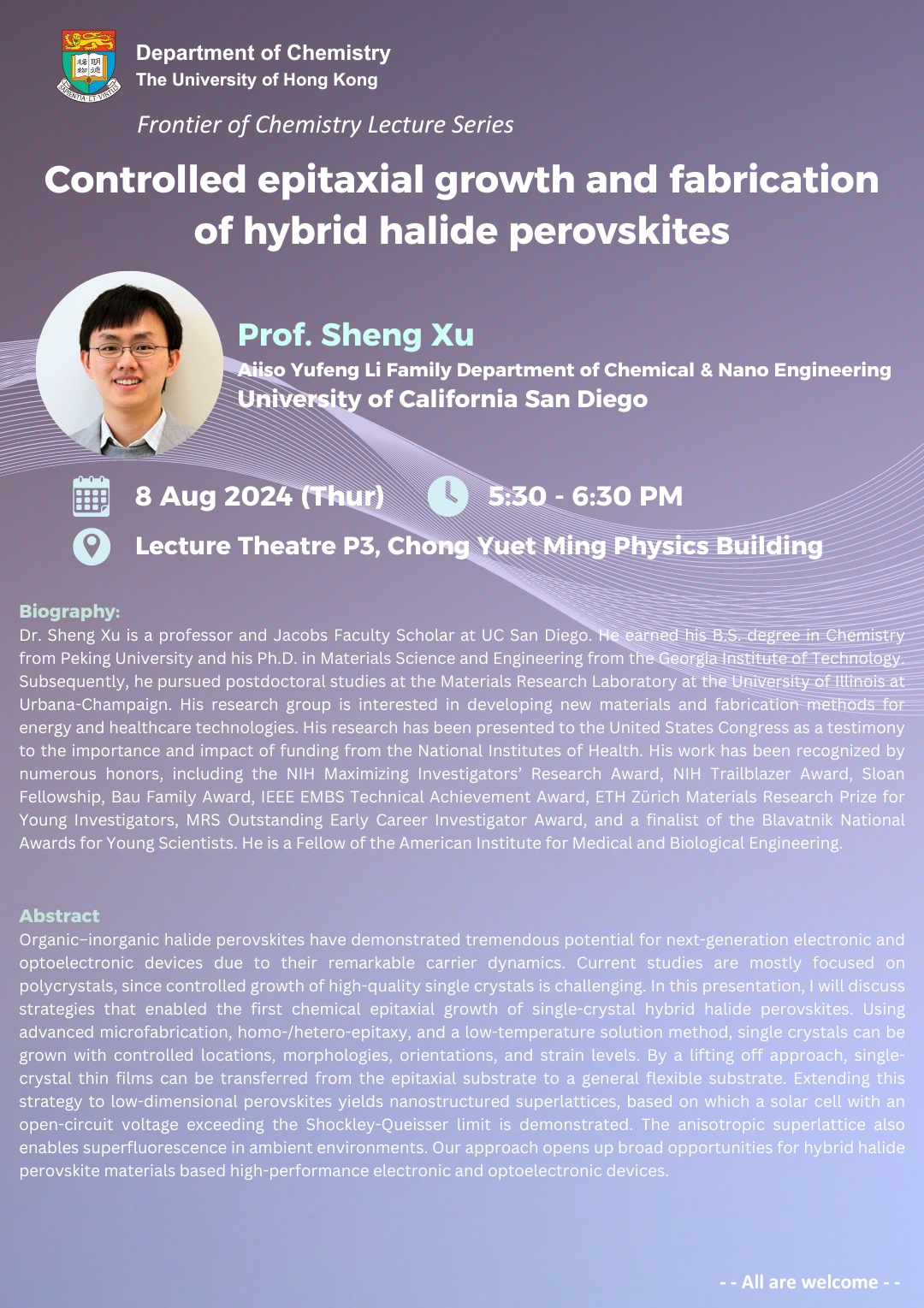| Date | 08 Aug 2024 |
| Time | 5:30 pm - 6:30 pm (HKT) |
| Venue | Lecture Theatre P3, Chong Yuet Ming Physics Building |
| Speaker | Prof. Sheng Xu |
| Institution | Aiiso Yufeng Li Family Department of Chemical & Nano Engineering, University of California San Diego |

Title:
Controlled epitaxial growth and fabrication of hybrid halide perovskites
Schedule:
Date: 8th August, 2024 (Thursday)
Time: 5:30 - 6:30 pm (HKT)
Venue: Lecture Theatre P3, Chong Yuet Ming Physics Building
Speaker:
Prof. Sheng Xu
Aiiso Yufeng Li Family Department of Chemical & Nano Engineering
University of California San Diego
Biography:
Dr. Sheng Xu is a professor and Jacobs Faculty Scholar at UC San Diego. He earned his B.S. degree in Chemistry from Peking University and his Ph.D. in Materials Science and Engineering from the Georgia Institute of Technology. Subsequently, he pursued postdoctoral studies at the Materials Research Laboratory at the University of Illinois at Urbana-Champaign. His research group is interested in developing new materials and fabrication methods for energy and healthcare technologies. His research has been presented to the United States Congress as a testimony to the importance and impact of funding from the National Institutes of Health. His work has been recognized by numerous honors, including the NIH Maximizing Investigators’ Research Award, NIH Trailblazer Award, Sloan Fellowship, Bau Family Award, IEEE EMBS Technical Achievement Award, ETH Zürich Materials Research Prize for Young Investigators, MRS Outstanding Early Career Investigator Award, and a finalist of the Blavatnik National Awards for Young Scientists. He is a Fellow of the American Institute for Medical and Biological Engineering.
Abstract:
Organic–inorganic halide perovskites have demonstrated tremendous potential for next-generation electronic and optoelectronic devices due to their remarkable carrier dynamics. Current studies are mostly focused on polycrystals, since controlled growth of high-quality single crystals is challenging. In this presentation, I will discuss strategies that enabled the first chemical epitaxial growth of single-crystal hybrid halide perovskites. Using advanced microfabrication, homo-/hetero-epitaxy, and a low-temperature solution method, single crystals can be grown with controlled locations, morphologies, orientations, and strain levels. By a lifting off approach, single-crystal thin films can be transferred from the epitaxial substrate to a general flexible substrate. Extending this strategy to low-dimensional perovskites yields nanostructured superlattices, based on which a solar cell with an open-circuit voltage exceeding the Shockley-Queisser limit is demonstrated. The anisotropic superlattice also enables superfluorescence in ambient environments. Our approach opens up broad opportunities for hybrid halide perovskite materials based high-performance electronic and optoelectronic devices.
- - ALL ARE WELCOME --
